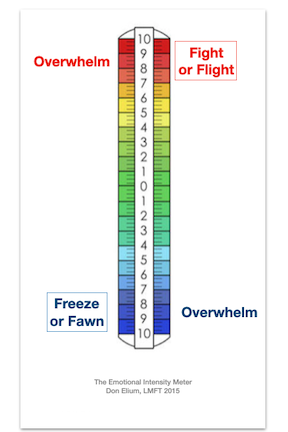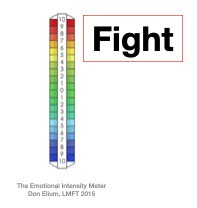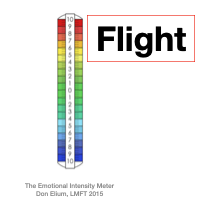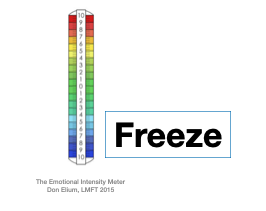FIGHT, FLIGHT, FREEZE and FAWN!
The FIGHT response is triggered when a person perceives a threat and decides to confront it aggressively. This reaction is marked by increased adrenaline, heightened arousal, and a readiness to defend oneself. Physiologically, this response involves tensing muscles, clenching fists, and a surge of energy, enabling a person to physically or verbally attack the source of the threat. This reaction aims to eliminate the danger by overpowering it.
Here are three examples of a FIGHT response:
Aggressive Behavior: Responding to a perceived threat with hostility, verbal aggression, or even physical confrontation, asserting dominance or control to protect oneself or others.
Argumentative Stance: Engaging in heated debates or arguments, pushing back against others' opinions or actions, and not backing down, even when it might escalate the situation.
Defensive Posture: Taking a strong stand or making forceful demands to defend personal boundaries, rights, or beliefs, often reacting impulsively to threats or perceived injustices.
THE FLIGHT response happens when someone senses a threat and chooses to escape it. This reaction is fueled by a surge of adrenaline that readies the body to flee and find safety. Physiologically, it involves increased heart rate, quick breathing, and a burst of energy focused on running away. This response aims to prevent harm by creating distance from the perceived danger and prioritizing safety through avoidance.
Here are three examples of a FLIGHT response:
Physically Leaving: Quickly exiting a stressful or threatening situation, such as leaving a room or an environment where conflict or danger is present, to seek safety elsewhere.
Avoidance Behavior: Consistently avoiding places, people, or situations that are perceived as threatening or stressful, such as not attending social events where confrontations might occur or avoiding certain tasks at work.
Distraction or Procrastination: Engaging in activities that distract from the stressful situation, like immersing oneself in work, hobbies, or screen time, or procrastinating on tasks that cause anxiety or discomfort.
RESEARCH NOTE: The fight-or-flight response is primarily driven by the sympathetic nervous system, leading to increased heart rate, blood pressure, and energy mobilization. The amygdala plays a crucial role in threat detection and activates the hypothalamus, which stimulates the adrenal medulla to release adrenaline. This cascade prepares the body for immediate action.
THE FREEZE response is triggered when an individual perceives a threat, but neither fighting nor fleeing seems viable. This reaction involves a temporary paralysis or inability to move or react, akin to playing dead. Physiologically, it consists of a drop in heart rate and numbness or immobility. This response aims to avoid detection by the threat, making oneself less noticeable in the hope that the danger will pass without further escalation.
Here are three examples of a FREEZE response:
Paralysis in Decision-Making: Feeling unable to make decisions or take action in a stressful situation, often feeling stuck or overwhelmed by fear or anxiety.
Emotional Numbness: Experiencing a sense of emotional detachment or numbness, where it becomes difficult to feel or express emotions, often as a way to cope with overwhelming stress or trauma.
Physical Stillness: Becoming physically immobile or frozen during a threatening or high-stress situation, such as being unable to move or speak during an argument or when facing a dangerous situation.
RESEARCH NOTE: Freezing is a form of behavioral inhibition characterized by parasympathetically dominated heart rate deceleration. It involves the amygdala's projections to the brainstem, particularly the PAG. Freezing allows for heightened sensory awareness and decision-making under threat. Neuroimaging studies in humans have shown that brain regions are involved in freezing similar to those in animals, with fronto-amygdala connections being critical for shifting between freezing and active defensive modes.
THE FAWN response is activated when an individual perceives a threat and chooses to appease or placate the source of danger to avoid conflict. This reaction involves ingratiating behaviors, compliance, and focusing on pleasing the danger. Physiologically, it can affect the calming of the body's stress responses as the person attempts to create a sense of safety through submission or agreeableness. This response aims to diffuse the threat by gaining favor and reducing hostility through subservience.
Here are three examples of a FAWN response:
Over-Accommodating Behavior: Going out of your way to meet others' needs or demands, even when it compromises your well-being or boundaries, to avoid conflict or gain approval.
Avoiding Confrontation: Avoid difficult conversations or disagreements to prevent conflict or tension, often agreeing with others even when you disagree internally.
Excessive Compliance: Agreeing to tasks or responsibilities beyond your capacity or comfort level to avoid disappointing others or to maintain harmony, often at the expense of your own needs or desires.
RESEARCH NOTE: The fawn response, though less studied, involves behaviors to appease the threat. It is thought to be mediated by social and affiliative neural circuits, including the prefrontal cortex and amygdala, which are involved in social behavior and emotional regulation.
SURVIVAL THINKING is dramatically distinct from REASONABLE THINKING. The survival reactions are evolutionary mechanisms designed to protect you from harm and ensure your survival in dangerous situations. These reactions occur whether there is an actual threat happening at the moment, a perceived threat, or a post-traumatic stress reaction from past threats. That's why you may find it difficult to think clearly and reasonably when the intensity of an argument passes the threshold level that feels threatening.






